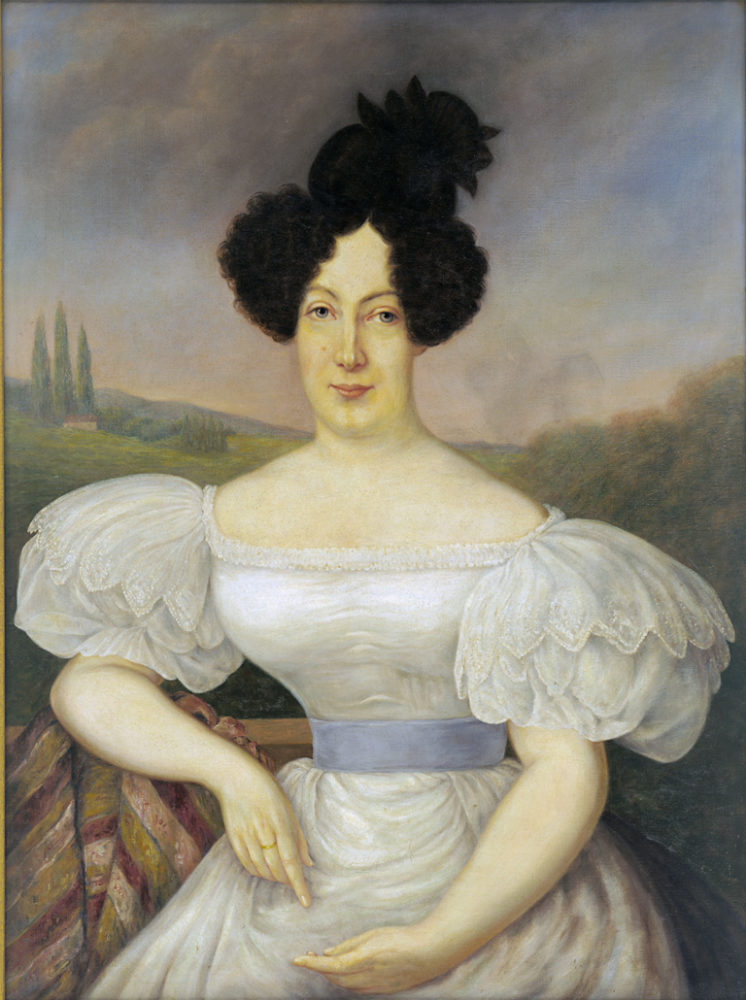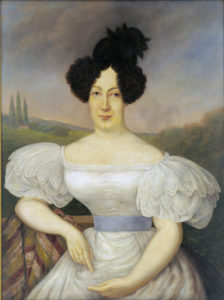Micaela Almonester, Baroness Pontalba
Micaela Leonarda Almonester de Pontalba was the sponsor of landmark architectural complexes in her native Louisiana, as well as in France, her home for sixty-seven years.

Courtesy of Louisiana State Museum
Baroness Pontalba. Schneider, Frank, (Artist)
Micaela Leonarda Almonester de Pontalba was the sponsor of landmark architectural complexes in her native Louisiana, as well as in France, her home for sixty-seven years. She conceived the Pontalba Buildings in New Orleans as two magnificent blocks of row houses facing each other on Jackson Square. Finished in 1851, they revitalized the declining center of the city and set the taste for elaborate cast ironwork in the Vieux Carré. Her showpiece mansion in Paris—now the US embassy residence—was built in 1840 with her close supervision. The Baroness Pontalba’s building projects were all the more remarkable because she undertook them after surviving a murderous attack by her father-in-law that left her permanently disfigured.
Inheritance
The daughter of the Spanish builder and philanthropist Don Andrés Almonester and Louise de la Ronde, Micaela was born in New Orleans. Though the town was small (population 6,000) and swampy, it was the capital of the enormous Spanish colony of Louisiana. Almonester made many important donations to New Orleans, including the grand St. Louis Cathedral on the city’s main square, flanked by the municipal hall (Cabildo), and the priest’s house (Presbytère)—all his benefactions. At Almonester’s death, when Micaela was three years old, his property surrounding the square passed to her and became the site of the Pontalba Buildings. (Almonester’s name was written various ways; streets named after him use Almonaster.) Micaela probably attended the day school of the Ursuline nuns a few steps from her home. Wherever her schooling, there was little of it for, when she was fifteen, her mother arranged a marriage with another Creole, twenty-year-old Célestin Delfau de Pontalba. The Pontalbas were then living in France. In 1811 Micaela Almonester was married in the St. Louis Cathedral her father had built. Then, accompanied by her mother, she sailed away to live unhappily ever after.
Life in France
The Pontalbas were penuriously residing in the Château Mont-l-Evêque in Senlis, fifty miles from Paris, where Célestin’s father, Baron Joseph Xavier de Pontalba, was the local dignitary. It became apparent early on that the elder Pontalba, called Xavier, had proposed the marriage not only with the respectable intention of matching his son with an heiress, but with the idea of seizing Micaela’s inheritance immediately. He began coercing the young girl and her mother to sign over more and more of her fortune to Célestin, that is, to himself, since he controlled every aspect of Célestin’s life. At one point, he forbade Micaela to see her mother unless she gave him half her property on the Place d’Armes (Jackson Square). At that particular time, Micaela had just buried her first child and was again pregnant. (She eventually bore five children, but only Célestin II, Alfred, and Gaston lived to adulthood.) Louisiana law continued to use the Code Napoléon even after the fall of Napoleon; therefore, Micaela’s properties in New Orleans were her separate assets. A Louisiana judge prevented the Pontalbas from appropriating them. In France, however, many aspects of the Code Napoléon were abrogated after Napoleon left power in 1815. France did not, for example, allow divorce. If a woman left her husband for any reason, he could take possession of her property and deny her access to their children. Xavier de Pontalba thus set out to make Micaela’s life so miserable that she would run away and leave him in possession of her considerable wealth. Micaela was epileptic, and during the hellish years of living with the Pontalbas, she began having daily seizures.
Shooting
When Micaela’s sons reached adolescence, one by one they escaped the boarding school where their grandfather had placed them and insisted on living with their mother in Paris. Since her sons were now near her, Micaela left Célestin and Mont-l’Evêque for three years; Célestin seized the houses in Paris that her mother had left her. However, there was apparently a strong attraction between the couple for, in 1834, a few days before their twenty-third wedding anniversary, Micaela decided to go to Mont-l’Evêque to talk with Célestin. No one knows what transpired between Micaela and Célestin during their three-hour meeting, but whatever happened enraged Xavier de Pontalba, who was by then eighty years old with a well-developed hatred of his daughter-in-law. The next morning, he trapped Micaela in an upstairs bedroom and fired at her four times point-blank. He shot away her left breast and two fingers of the hand she put up to grab the muzzle of his gun. Realizing that he was out of ammunition and had not killed her, the old man retreated in despair and killed himself. Micaela survived, though she remained a semi-invalid for years. A French tribunal finally awarded her control of her property—but only after two harrowing trials. Finally freed from the Pontalbas’ constraints, she built the Hôtel Pontalba, her townhouse on Rue St. Honoré in 1840. Her showpiece mansion, which is now the U.S. embassy residence, was constructed by the noted architect L.-T.-J. Visconti. Micaela, however, supervised every detail. Then in 1849 she returned to New Orleans, bringing the plans and specifications for the ambitious Pontalba Buildings.
Pontalba Buildings
New Orleans was, by this time, one of the five largest cities in the United States, but its old center was deteriorating, surrounded by new American entrepreneurs and architecture. Micaela engaged a gifted contractor, Samuel Stewart, to build thirty-two row houses surrounding Jackson Square, the historic heart of the city. The sixteen houses on each side would share a common wall, with shops on the ground floors and living quarters above.
The exterior design of the Pontalba Buildings is a mixture of styles. Its lines are Greek Revival, but its columns are thin, graceful shafts instead of the typically massive, round supports. The faces of the buildings are gaily decorated in iron similar to the much plainer ironwork being used at the time in Paris. A poetic AP monogram—Almonester/Pontalba—weaves through the iron lace, a design by Micaela’s son Gaston, who was a gifted artist. The buildings resemble the color and layout of Paris’s Place des Vosges. Inside, however, they were constructed like classic Creole cottages. Among the first tenants was the famous soprano Jenny Lind, who stayed in one of the houses when she performed in New Orleans.
Return to France
Micaela left New Orleans in March 1851, never to return. When she arrived back in Paris, her husband Célestin was waiting for her. Though they had been separated for fifteen years, he begged her to manage his property and to care for him since, as Micaela stated in one of her letters, he was “losing more of his mind by the minute.” Within a year he was completely incapacitated. She cared for Célestin for twenty-three long years, until her death in 1874 at the age of seventy-nine. Célestin Micaela, watched over by servants, lived to be eighty-seven. They are buried together in a tomb at Mont-l’Evêque.
